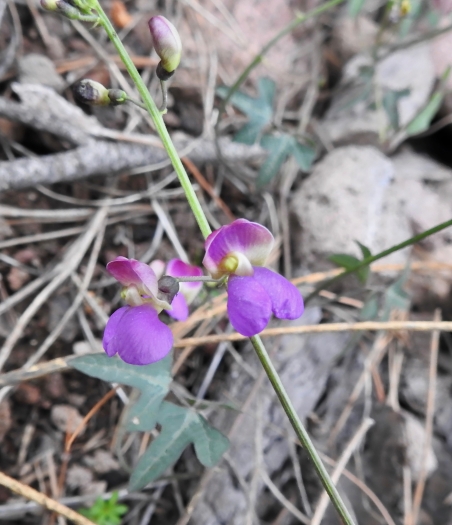Sonoran Bean
(Phaseolus pedicellatus)
Sonoran Bean (Phaseolus pedicellatus)
/
/

Laura Gaudette
CC BY 4.0
Image By:
Laura Gaudette
Recorded By:
Copyright:
CC BY 4.0
Copyright Notice:
Photo by: Laura Gaudette | License Type: CC BY 4.0 | License URL: http://creativecommons.org/licenses/by/4.0/ | Rights Holder: Laura Gaudette | Publisher: iNaturalist | Date Created: 2019-08-08T21:10:27-07:00 |






















Estimated Native Range
Summary
Phaseolus pedicellatus, commonly known as Sonoran Bean, is a deciduous perennial vine native to arid and semi-arid regions, including desert scrub, grasslands, and open woodlands in the Southwestern USA and Northern Mexico. It typically grows to a height of 3-9 feet (0.9-2.7 meters) and a width of 1-2 feet (0.3-0.6 meters). The vine has a twining habit and produces clusters of showy white flowers during the summer months, which are followed by edible beans that are both ornamental and useful for culinary purposes.
The Sonoran Bean is valued for its drought tolerance and ability to thrive in hot, dry climates, making it an excellent choice for xeriscaping and low-water-use gardens. It is also used in restoration projects to stabilize soils and provide habitat for wildlife. In cultivation, it requires full sun exposure and well-drained soils. While it is relatively low-maintenance, it may need support to grow vertically. It is not commonly afflicted by diseases but can be susceptible to bean common mosaic virus. The plant is not known for being invasive outside its native range, but gardeners should always monitor for unexpected spread.CC BY-SA 4.0
The Sonoran Bean is valued for its drought tolerance and ability to thrive in hot, dry climates, making it an excellent choice for xeriscaping and low-water-use gardens. It is also used in restoration projects to stabilize soils and provide habitat for wildlife. In cultivation, it requires full sun exposure and well-drained soils. While it is relatively low-maintenance, it may need support to grow vertically. It is not commonly afflicted by diseases but can be susceptible to bean common mosaic virus. The plant is not known for being invasive outside its native range, but gardeners should always monitor for unexpected spread.CC BY-SA 4.0
Plant Description
- Plant Type: Vine
- Height: 3-9 feet
- Width: 1-2 feet
- Growth Rate: Moderate
- Flower Color: White
- Flowering Season: Summer
- Leaf Retention: Deciduous
Growth Requirements
- Sun: Full Sun
- Water: Medium
- Drainage: Medium
Common Uses
Edible*Disclaimer: Easyscape's listed plant edibility is for informational use. Always verify the safety and proper identification of any plant before consumption., Low Maintenance
Natural Habitat
Arid and semi-arid regions, including desert scrub, grasslands, and open woodlands
Other Names
Common Names:
Scientific Names: , Phaseolus pedicellatus,
GBIF Accepted Name: Phaseolus pedicellatus Benth.